|
ROB
MAYNARD LOOKS BACK AT DONALD SIMMONDS
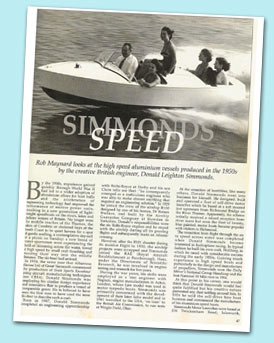 This
feature is reproduced from an article that was
first published in the June 1991 issue of Classic
Boat, pages 47, 48, 49. This
feature is reproduced from an article that was
first published in the June 1991 issue of Classic
Boat, pages 47, 48, 49.
Simmonds Speed
Rob Maynard looks at the high speed
aluminium vessels produced in the 1950s by the creative
British engineer, Donald Leighton Simmonds.
By
the 1950s, experience gained quickly through World War
Il had led to a wider adoption of aluminium alloys for
boat hulls and the acceleration of engineering technology
had improved the weight speedboats on the rivers, lakes
and inshore waters of Britain. No longer were he middle
reaches of the Thames, the lakes of Cumbria or sheltered
bays of the South Coast to be quiet havens for a spot
of gentle sculling, a contemplative day-sail IT a picnic
on Sunday: a new breed of water-sportsmen were experiencing
the thrill of skimming across flat water, towed it high
speed by small craft thrashing and buzzing their way
into the middle distance. The ski-boat had arrived.
In 1954, the same year that Albatross
Marine Ltd of Great Yarmouth commenced the production
of their Sports Runabout using aircraft manufacturing
techniques (See CB14), Donald Simmonds was employing
his similar experience and innovative flair to produce
a vessel of comparable genre. He is believed to have
seen the first man to have used the term Ski-Boat to
describe such a craft.
Born
in 1907, Donald Simmonds completed an engineering apprenticeship
with Rolls-Royce at Derby and his son Chris tells me
that “he consequently emerged as a meticulous
engineer who was able to make almost anything that required
an engineering solution." In 1929 he joined the
crew of the airship R100 designed by one of his heroes,
Dr Barnes Wallace, and built by the Airship Guarantee
Company at Howden in Yorkshire. Donald's responsibilities
were the six Rolls-Royce engines and he stayed with
the airship during all its proving flights and subsequently
made an Atlantic crossing.
However,
after the R101 disaster during its maiden flight in
1930, the airship projects were scrapped and Simmonds
joined the RAE (Royal Aircraft Establishment ) at Farnborough.
Here, under the Directorate of Scientific Research,
he was involved in engine testing and research for five
years.
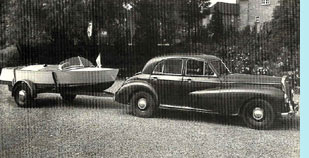 During
the war years, his skills were employed as a test engineer
with Napiers, engine manufacturers in Acton, London,
whose Lion model was used in motor torpedo boats. Simmonds
was primarily concerned with the development of their
later Sabre model and in 1941 travelled to the USA,
'on loan' to the British Air Commission, to run tests
at Wright Field, Ohio. During
the war years, his skills were employed as a test engineer
with Napiers, engine manufacturers in Acton, London,
whose Lion model was used in motor torpedo boats. Simmonds
was primarily concerned with the development of their
later Sabre model and in 1941 travelled to the USA,
'on loan' to the British Air Commission, to run tests
at Wright Field, Ohio.
At the cessation of hostilities, like
many others, Donald Simmonds went into business for
himself. He designed, built and operated a fleet of
self-drive motor launches which he based at a raft moored
just upstream from Richmond Bridge on the River Thames.
Apparently, the scheme initially received a mixed reception
from river users but soon the fleet of twenty, blue
painted, motor boats became popular with visitors to
Richmond.
The
transition from flight through the air to speed across
water was completed when Donald Simmonds became interested
in hydroplane racing. In typical fashion he built his
own craft, "Wollibong", in which he raced
with considerable success during the early 1950s. Gaining
much experience in high speed boats, particularly in
the design and manufacture of propellers, Simmonds won
the Daily Mirror's National Group Handicap and the first
National 50 Mile race in 1954.
At
this point in his career, one would think that Donald
Simmonds would feel quite fulfilled, but his creative
nature prevented any dust settling around him. In 1954
he sold the self-drive hire boat business and commenced
the manufacture of his aluminium speed boats. 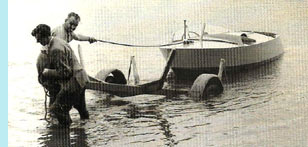
Simmonds
Motor Launches were based at 236 Twickenham Road, Isleworth,
Middlesex or, as Chris Simmonds puts it, "the early
boats were built in a 20' by 20' (6.1 x 6.1m) shed in
our back garden at Isleworth which became office, factory
and home.”
The prototype Ski-Boat was put through
most of its trials on the Thames at Richmond, out of
season. Chris Simmonds remembers that "an interesting
feature of the first boat was that it had a largish
blister on the bottom of the hull to house the engine
oil sump. Surprisingly, this did not seem to effect
the performance adversely although it was done away
with on subsequent boats."
The
first production boat made its public debut at a
water ski meeting at Ruislip Lido in September 1954.
The boat had an overall length of 14'(4.3m) with
a 5'4"(1.6m)
beam and, with its 1 1/2 litre Ford engine, had an
all-up weight of S501b(386kg). This boat, number
one, was sold to the then head of Aston Martin cars
and David Brown Tractors, David Brown himself and
was used as a tender to his yacht Marsaltese II.
The
engines fitted as standard to the 14’ (4.3m)
Simmonds ski-boat were marinised Mark II Consul
models with twin down draught carburettors incorporating
accelerator pumps, producing a maximum output of
51bhp at 4,400rpm. Simmonds supplied this engine
for use in other boats as well as their own. The
price, complete with 12 volt generator, starter
and ignition coil, was set at £197 in 1957 – items
such as a starter solenoid and voltage regulator
were deemed extras!”
If the cost at less than £200
didn't persuade you to invest, the company’s literature
was likely to convince you: "In a well designed
boat the instant surge of power is most impressive and
the craft will flash up to full speed in a few seconds."
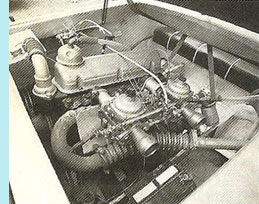 It
was probably true. Built to accommodate three people
forward and two in the rear bench seat, with the engine
between, these little vessels could achieve speeds of
between 35 mph and 40 mph. More than this, they could
also pull multiples of waterskiers out of the water
and onto the plane. Such was the performance that power
plant and hull design could achieve, the literature
distributed at the National Boat Show, held at Olympia
in 1957, boasted that "Six water skiers can be
towed off simultaneously and enjoy a fast, crisp ride
in company. The speed when towing is sufficient for
championship competitions and jumping." All this
for £795. It
was probably true. Built to accommodate three people
forward and two in the rear bench seat, with the engine
between, these little vessels could achieve speeds of
between 35 mph and 40 mph. More than this, they could
also pull multiples of waterskiers out of the water
and onto the plane. Such was the performance that power
plant and hull design could achieve, the literature
distributed at the National Boat Show, held at Olympia
in 1957, boasted that "Six water skiers can be
towed off simultaneously and enjoy a fast, crisp ride
in company. The speed when towing is sufficient for
championship competitions and jumping." All this
for £795.
The
1957 claim almost certainly referred to a later model
which was powered by a 1700cc, four cylinder, overhead
valve Ford Engine, which had a power output varying
From 57bhp to over 70bhp according to tuning and the
equipment fitted. As the engines were designed to run
for long periods at full throttle, a need for cooling
the oil and exhaust was found necessary - there was
little chance of the engines overheating. They were
also provided with closed circuit, thermostatically
controlled fresh water coaling which circulated through
a heat exchanger in the hull bottom as a standard feature.
The instruction manual of 1963 warned that the bottom
of the boat should not be painted or engine cooling
could be impaired.
Production of the boats and engines
continued with some success through to the early 1960s
and during this time Donald Simmonds rented workshop
space from Tough Brothers of Teddington, on the Thames,
where some of the more substantial construction took
place.
A
great testimony to the Ski-Boat's performance was reflected
in the achievements of Mr S F Pearson with Optimist
in 1960. He did not start to race her until August of
that year, but had won three firsts, including the Lady
Brecknock Trophy, before the end of the month. This
he achieved at maximum reported speeds of 50mph but
he did have a specially converted engine behind him;
the Raymond Mays Ford Zephyr cylinder head conversion
boasted triple carburettors. However, the success of
Optimist led the Simmonds company to claim
" . . . It's simple with Simmonds" in their
1961 advertising campaign.
It was the high point in the history
of Simmonds Ski-Boats. In the early 1960s Donald Simmonds
sold the company to a Major Wood of Huwood Engineering
and by 1963 the production had moved up to Newcastle
upon Tyne and little more is known. Of Simmonds himself,
Chris Simmonds takes up the story. “My parents
moved to Lymington in Hampshire where my father my father
set up a one man firm called Precision Propellers. He
made propellers to order, for offshore powerboats, which
were in great demand and pretty expensive. I fact, things
were working out quite successfully when he died at
the early age of 57 in 1964."
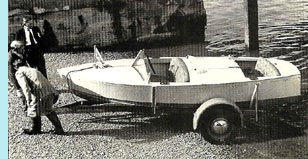 It
was not, however, the end of the Simmonds Ski-Boats
story. A revival of interest in such aluminium-built
boats of the Fifties and early Sixties has led to the
discovery and restoration of some models by enthusiastic
individuals. One such is Alan Fawcus who, at the age
of 14, was first captivated by these craft while on
holiday at Ullswater in Cumbria in 1965. So inspired
was he that when he returned home, he constructed his
own 5' (1.5m) version from old pieces of plywood, complete
with tumblehome at the after end - for him the most
important feature of a 'real' motor boat. It
was not, however, the end of the Simmonds Ski-Boats
story. A revival of interest in such aluminium-built
boats of the Fifties and early Sixties has led to the
discovery and restoration of some models by enthusiastic
individuals. One such is Alan Fawcus who, at the age
of 14, was first captivated by these craft while on
holiday at Ullswater in Cumbria in 1965. So inspired
was he that when he returned home, he constructed his
own 5' (1.5m) version from old pieces of plywood, complete
with tumblehome at the after end - for him the most
important feature of a 'real' motor boat.
Despite owning successive boats, including
an Owens model which he used as a recovery craft on
Lake Coniston during an attempt by Tony Fahey on the
World Water Speed Record in 1982, Alan still longed
for an aluminium vessel. He advertised for a two-seater
Albatross and in response was offered three or four
boats, including a Simmonds. "I had heard of the
name but really knew no more. When I approached the
owner's house, the partially dismantled boat was standing
outside. 'I saw the back first and there was that beautifully
tapered stern - I had bought it before I stopped the
car!"
Some
parts, including most of the paint, were missing but,
using his experience as a Marine engineer, he manufactured
and adapted components to fit and got the boat ready
for the water. Two months later he was ready for testing
and took the boat to a quiet loch in Scotland for his
first run. "I fired it up and my wife Carol cast
off and pushed out the bow so that it pointed down the
loch. I engaged the clutch and it immediately accelerated
to 8 mph, then to 12 mph, but no more, even at full
throttle. Everything I knew about engines was going
through my mind as I turned back to the jetty."
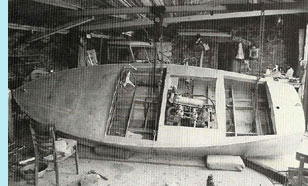 He
swapped spark plug leads, checked the exhaust cooling
water supply -maybe the engine was filling up with water?
- took her out on a number of further trials and at
last discovered that the rear of the exhaust manifold
was cold: a butterfly valve on one of the carburettors
was not working. “The screw that held the linkage
together was loose; half a turn and off we went: 33
mph, with the wonderful feeling at last, twenty five
years after seeing the first one, I had got the boat
that I wanted.” He
swapped spark plug leads, checked the exhaust cooling
water supply -maybe the engine was filling up with water?
- took her out on a number of further trials and at
last discovered that the rear of the exhaust manifold
was cold: a butterfly valve on one of the carburettors
was not working. “The screw that held the linkage
together was loose; half a turn and off we went: 33
mph, with the wonderful feeling at last, twenty five
years after seeing the first one, I had got the boat
that I wanted.”
Most bystanders thought that Alan's
boat was a four seater Albatross but some recognised
it as a Simmonds. "They were mostly forty to fifty
year old water skiiers who had learned to ski behind
one and said that they were damned good boats. During
that weekend at Loch Kindar, Dumfries and Galloway,
the Simmonds Ski-Boat attracted a lot of attention and
Alan concedes "some were attracted by the sound."
Alan's boat is number 539. She used
to belong to Ullswater Ski Cub and, just by the wear
on the ski hitch, would appear to have worked hard.
Alan believes that she was probably amongst the last
of the Ski-Boats to have been built.
There would appear to be few Simmonds
Ski-Boats still surviving and, during his search for
authentic parts, Alan Fawcus is compiling a record of
those that he located He is restoring his own boat to
its original specification, even down to the correct
paint colours with the help of International Paints
who have historical records. The engine cover, which
had a hole cut into it to allow the fitting of a non-standard
2"(50mm) SU carburettor at some point in the boat's
history, is also being restored. This job is being undertaken
by panel beater, Paul Vevers who, as an apprentice was
sent to Coniston Water, Cumbria to repair one Bluebird’s
pontoons after Dr Donald Campbell had hit the dock.
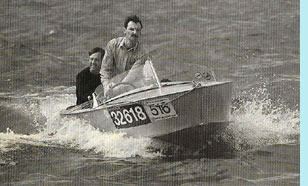 Alan
Fawcus is lucky in that his boat was still sitting on
its original 'Simmonds Keel Locating Trailer' which,
according to the manufacturer, was "available for
high speed trailing" and would "greatly enhance
the pleasure to be obtained from these boats. Launching
and hauling can be a very easy operation as the self-locating
arrangements make it possible to position the boat without
risk of damage or additional help." Alan
Fawcus is lucky in that his boat was still sitting on
its original 'Simmonds Keel Locating Trailer' which,
according to the manufacturer, was "available for
high speed trailing" and would "greatly enhance
the pleasure to be obtained from these boats. Launching
and hauling can be a very easy operation as the self-locating
arrangements make it possible to position the boat without
risk of damage or additional help."
It seems that Donald Simmonds had thought
of everything, he designed and built the boats, marinised
the engines that powered them, designed and made the
11" diameter by 9" pitch propellers (2 mm
229 mm) that drove them through the water, designed
the trailers so that one man could get the boat to and
from the water and he relished driving them himself.
With
the advent of GRP, the days of rivetted aluminium for
speed and construction were numbered and today they
represent a small part of marine history but, unlike
their modern day successors, they are truly characteristic
of British post-war motor boating, and the Simmonds
Ski-Boat, perhaps, the quintessential example.
With
thanks to Rob Maynard and Classic
Boat magazine |